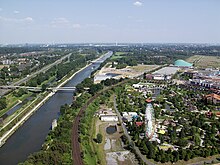Urban landscape (geography)

Cityscape ( English urban landscape ) is a collective term for urban embossed areas . It is associated with the geomorphological and urban morphological or landscape , settlement and urban geographic conception of a section of the earth's surface in which an agglomeration of settlements of different densities and open spaces , including predominantly anthropogenically redesigned landscapes ( cultural landscapes , urban landscapes ), are to be found.
Today's geographical view of an urban landscape can refer to spatially different levels, to spaces within a city and urban region, but also to large-scale structures such as a megalopolis .
History of concepts and ideas
The geographical term urban landscape goes back mainly to social geographers who used it around 1920 to identify cities within delimitable cultural landscapes or cultural areas , and then to Siegfried Passarge , who published it in several publications at the beginning of the 20th century as part of the landscape geography he founded . Century. Passarge understood the urban landscape as part of a cultural landscape and as a contrast to the natural landscape . Furthermore, he recognized in it certain cultural development requirements that shape its character (city character), and a political factor in the sense of a "community of interests" of people who organize themselves politically in the form of cities through to city-states and city leagues .
The historical and geographical view of a city can be traced back to the perspective of the picturesque urban landscape and the cityscapes of the 16th to 19th centuries. Accordingly, a city was first viewed from the outside in its natural spatial location. With the increasing development of urban geography , the surrounding landscape not only represented a physiognomic and pictorial framework of a city and its cityscape , but was also understood as an essential prerequisite for the living conditions, economic and social forms that prevail in it.

In the course of history, the concepts of the city to be planned and built, urban space and urbanity developed . In this context, it is important that garden theory and urban planning were increasingly integrated in the course of the 19th century . This circumstance gave rise to the ideas of the garden city and the city and people's park as well as the disciplines of open space and landscape planning , which aimed at eliminating the historical contrast between city and country in new planning models. Around 1900 the idea of the city as a landscape was already a widespread literary metaphor when the architect and art theorist August Endell took it up to describe the beauty of the rapidly growing metropolis of his time and the processes of urbanization taking place in it . Inspired by the planning principles of the Congrès Internationaux d'Architecture Moderne , plans emerged in the 20th century that understood the modern urban space as a spacious landscape that was car-friendly through settlement and open space. These include the collective plan that was developed in 1945/1946 under the leadership of Hans Scharoun and Wils Ebert for the reconstruction of Berlin , or the concept of organic urban architecture by Hans Bernhard Reichow published in 1948 .
In 1960, the American urban planner and author Kevin A. Lynch, in view of the phenomena of suburbanization , summarized under the term urban landscape “the undesigned urban agglomerations” and said that an urban landscape is something “that one can see, remember and work with should be happy ”. The German architect and urban planner Thomas Sieverts said in 1997 that in the urban sprawl, a “close-knit interpenetration of open space and settlement” and the “open space of the urban landscape” could be recognized and that new design perspectives could be gained.
literature
- Dietrich Denecke : Ways of historical geography and cultural landscape research . Franz Steiner Verlag, Wiesbaden 2005, ISBN 3-515-08680-3 , p. 134 ff.
- Anngret Simms: New ways of historical-geographical exploration of urban landscapes in Anglo-American geography . In: Peter Johanek , Franz-Joseph Post (ed.): Many cities. The concept of the city . Cities research A / 61, Böhlau Verlag, Cologne 2004, ISBN 3-412-10603-8 , p. 53 ff.
Web links
- Urban landscape , entry in the portal Spektrum.de
Individual evidence
- ↑ Werner Durth : Urban landscape in reconstruction . In: Hubertus Fischer (ed.): Shaping the future from landscape. Keywords for landscape architecture . Akademische Verlagsgemeinschaft München, Munich 2014, ISBN 978-3-95477-009-0 , p. 219.
- ↑ Max Eckert : The development of the cartographic representation of city landscapes . In: Siegfried Passarge (ed.): City landscapes of the earth . Hamburg 1930, p. 1.
- ^ Siegfried Passarge: Landscape and cultural development in our climatic areas . L. Friederichsen & Co., Hamburg 1922, pp. 106, 117 ( digitized version )
- ^ Hanno-Walter Kruft: History of the architectural theory. From antiquity to the present . Verlag CH Beck, study edition, Munich 1991, ISBN 3-406-34903-X , p. 308.
- ↑ August Endell : The Beauty of the Big City . Published by Strecker & Schröder, Stuttgart 1908.
- ^ Hans Bernhard Reichow : Organic city architecture. From the big city to the urban landscape . Georg Westermann, Braunschweig 1948.
- ↑ Kevin A. Lynch : The image of the city . Bauwelt Fundamente, Volume 16, Ullstein, Berlin 1965 (Original: The Image of the City , 1960). Quoted from: Jürgen Hotzan: dtv-Atlas zur Stadt. From the first foundations to modern urban planning . Deutscher Taschenbuch Verlag, Munich 1994, ISBN 3-423-03231-6 , p. 205.
- ^ Thomas Sieverts : Zwischenstadt . Bauwelt Foundations, Volume 118, Friedr. Vieweg & Sohn, Braunschweig 1997, ISBN 3-528-06118-9 , p. 66.
